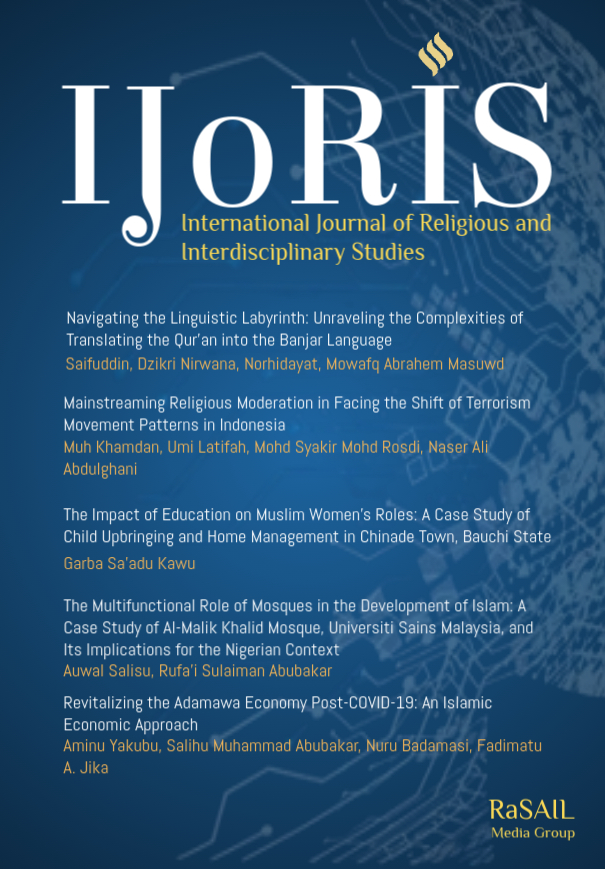Talfeeq in Islamic Jurisprudence: Classical Debates, Cross-Madhhab Analysis, and Contemporary Applications
DOI:
https://doi.org/10.64529/an44xe14Keywords:
Talfeeq, Islamic Jurisprudence, Cross-Madhhab Analysis, Maqasid al-Shariah, Contemporary Fiqh ApplicationsAbstract
This article examines talfeeq—the combination of juristic rulings from different Sunni schools of Islamic law—as its material object, focusing on its historical evolution, doctrinal boundaries, and contemporary relevance. The study aims to clarify the legitimacy of talfeeq, evaluate the divergent positions of classical and modern jurists, and determine the extent to which talfeeq can function as a valid jurisprudential tool in modern legal systems. Using a qualitative doctrinal method, the research analyzes classical fiqh texts, contemporary scholarly writings, and recent resolutions from international fiqh academies through comparative and thematic analysis. The study finds that while the majority of classical jurists imposed strict limitations on talfeeq, modern legal institutions increasingly adopt it to address financial, familial, and socio-legal complexities that cannot be resolved within a single school. The findings also indicate that talfeeq, when aligned with maqāṣid al-sharī‘ah and applied within coherent methodological safeguards, enhances legal flexibility without undermining jurisprudential integrity. The article contributes to contemporary Islamic legal studies by offering a structured comparative framework for understanding talfeeq, bridging classical debates with current applications, and highlighting methodological criteria necessary for its responsible use.
References
Ahmed Ali and Zain Hassan. (2020). Epistemological Challenges in Interfaith Dialogue. Journal of Religious Studies, 58(3).
Alister E. McGrath. (2015). Christianity: An Introduction. Wiley-Blackwell.
C. Taylor. (2016). The Legacy of Colonialism in Religious Relations. University of Toronto Press.
David Jones. (2021). Overcoming Epistemological Barriers in Interreligious Communication,”. Philosophical Perspectives on Religion, 34(1).
David Tracy. (2002). The Analogical Imagination: Christian Theology and the Culture of Pluralism. Crossroad.
Hans Küng. (2004). Global Responsibility: In Search of a New World Ethic. Crossroad.
Hans Küng. (2007). Theology of World Religions. Beck.
Harvey Cox. (2005). The Secular City: Secularization and Urbanization in Theological Perspective. Princeton University Press.
Ichwan, M. N., Ming, D., & Sya’roni, M. (2025). Bridging Tradition and Modernity: Integrating Classical Interpretation and Modern Hermeneutics through Ijtihad in Qur’an Studies. Pharos Journal of Theology, 106(SpecialIssue-2), 1–12. https://doi.org/10.46222/pharosjot.106.2021
J. Miller & H.Ward. (2020). The Fear of Pluralism: Challenges in Interfaith Dialogue. Routledge.
John F. Sullivan. (2014). The Role of Theology in Interfaith Dialogue. Cambridge University Press.
John Hick. (1989). An Interpretation of Religion: Human Responses to the Transcendent. Yale University Press.
John Hick. (2004). God and the Universe of Faiths: Essays in the Philosophy of Religion. Macmillan Publishing Co., Inc.,.
John Wesley. (2002). Theology of the Heart. Abingdon Press.
Jürgen Moltmann. (1993). The Crucified God. Fortress Press.
Jürgen Moltmann. (2000). The Coming of God: Christian Eschatology. Fortress Press.
Karen Armstrong. (2009). The Case for God. Alfred A. Knopf.
Karl Rahner. (1978). Foundations of Christian Faith: An Introduction to the Idea of Christianity. Crossroad.
L. Chen. (2021). Digital and Artistic Approaches in Interfaith Engagements. Springer.
Linda Gilliat-Ray. (2005). Muslim Society in the West. Oxford University Press.
Manuel Castells. (2000). The Rise of the Network Society. Blackwell.
Marshall McLuhan. (1964). Understanding Media: The Extensions of Man. McGraw-Hill.
Martha Nussbaum. (2008). The Clash Within: Democracy, Religious Violence, and India’s Future. Harvard University Press.
Miroslav Volf. (1998). After Our Likeness: The Church as the Image of the Trinity. Eedermans.
Miroslav Volf. (2000). usion and Embrace: A Theological Exploration of Identity, Otherness, and Reconciliation. Abingdon Press.
Miroslav Volf. (2001). Exclusion and Embrace: A Theological Exploration of Identity, Otherness, and Reconciliation. Abingdon Press.
N.T. Wright. (2011). Simply Jesus: A New Vision of Who He Was, What He Did, and Why He Matters. HarperOne.
Paul Murray. (2012). Christianity and Interfaith Dialogue. Oxford University Press.
Peter Berger. (1990). The Sacred Canopy: Elements of a Sociological Theory of Religion. Doubleday.
R. Jackson. (2017). Interfaith Dialogue and Epistemological Divergences. Bloomsbury Academic.
R. Kearney. (2015). Philosophy in Comparative Theology. Beacon Press.
Rebecca Smith and Henry Taylor. (2020). Interfaith Dialogue for Global Peacebuilding. Global Theology Journal, 12(2).
Richard Bauckham. (2006). The Bible in the Contemporary World: Hermeneutical Ventures. Baker Academic.
Shoshana Tavuchis. (2011). The Social Context of Religious Dialogue. Routledge.
Volf, M. (2006). The End of Memory: Remembering Rightly in a Violent World. Eedermans.
William B. Garrard. (2013). Religion and Social Justice. University Chicago Press.
William L. Lane. (2006). The Gospel According to Mark. Eedermans.
Published
Issue
Section
License
Copyright (c) 2025 Zafer Ahmad Ganai, Nasir Nabi (Author)

This work is licensed under a Creative Commons Attribution-NonCommercial-ShareAlike 4.0 International License.














